You'll have seen the specs, you'll have read the reviews and you'll have noted that Samsung has put a larger gap between the regular Galaxy S21 and the Galaxy S21 Ultra.
The Ultra is now the true flagship, having strengthened its position from the S20 Ultra in 2020 that we were never really sold on. The new model is much better overall - and the camera plays a big part in that.
But how do these cameras really differ in the real world? We're diving deep to take a closer look, with plenty of samples for you to examine.
Samsung Galaxy S21 Ultra camera specs
-
Quad rear camera:
- Main: 108-megapixels, 0.8µm pixel size, f/1.8 aperture, optical stabilisation (OIS), laser autofocus
- Ultra-wide (120°): 12MP, 1.4µm, f/2.2
- Telephoto (10x): 10MP, 1.22µm, f/4.9, OIS
- Telephoto (3x): 10MP, 1.22µm, f/2.4, OIS
- Selfie camera: 40MP, 0.7µm, f/2.2
Samsung Galaxy S21 Ultra 5G - 128GB (Black)
Let's start with a quick recap. Samsung leads with big resolution on the main S21 Ultra camera, with 108-megapixels on that sensor. It uses a system which Samsung calls "nona binning", which literally means you take nine pixels and treat it as one super pixel - 108 divided by 9 equals 12 - and it's a 12-megapixel photo that you get as a result.
The ultra-wide camera is 12-megapixels, but comes out at 0.6x zoom, so slightly different to the 0.5x version on the S21, but it's pretty much the same spec. Note that this camera is fixed focus.
Finally you have two telephoto lenses. To achieve the 100X Space Zoom - and all the focal lengths up to that maximum - Samsung is using two separate cameras, one for near images with a 3x lens and one for far images with a 10x lens. It's the latter which is a folded, or periscope, lens, which is needed to get that magnification without having a really thick phone.
Both zoom cameras have 10-megapixel sensors, but Samsung upscales the images to 12-megapixels in the final images, so that there's consistency in image size in the gallery - but we don't really see any benefit to that upscaling.
Finally, the front camera sticks to high resolutions with a 40-megapixel sensor, although this again uses pixel binning to give either 10-megapixel images, or uses sensor cropping and binning to give a 6.5-megapixel image.
Samsung Galaxy S21 camera specs
-
Triple camera system
- Main camera: 12-megapixel, 1.8µm pixel size, f/1.8 aperture, OIS
- Ultra-wide (120°): 12MP, 1.4µm, f/2.2
- Telephoto: 64MP, (3x hybrid optic / 30x digital zoom) 0.8µm, f/2.0, OIS
- Selfie: 10MP, 1.22µm, f/2.2
The Galaxy S21 and S21+ have the same camera systems and differ from the S21 Ultra in many ways. While the camera app, photo modes and video offerings are generally the same, the cameras are wildly different.
The main camera here is a 12-megapixel sensor and on paper the same as the Galaxy S20. Rather than taking a high-resolution approach, it opts for larger pixels, at 1.8µm, designed to absorb more light.
There is a nod to high-resolution shooting however, with the telephoto camera. This has a 64-megapixel sensor and it does three jobs. The first is that it provides the resolution for 8K video capture (for which you need 33 megapixels). Second it offers 64-megapixel photos and thirdly, it acts as the telephoto offering, claiming a 3x hybrid optic magnification.
What's wrong with this picture? You can't offer all these things through a magnified lens because you'd end up too close to the subject - so there's actually no optical magnification from the lens at all - the zoom is derived from sensor cropping - hence the hybrid optic naming.
How do we know this? When you engage 64-megapixel shooting from the telephoto lens, the view you get is identical to that from the main camera - it's the same focal length, so you know there's no zoom in the lens itself.
Finally on the rear we have the ultra-wide camera, which as we said, is pretty close to the offering in the S21 Ultra and again it is fixed focus.
The front camera is 10-megapixel pixels, again offering either a wide 10-megapixel photo or a closer 6.5-megapixel crop.
Comparing the S21 and S21 Ultra main cameras
With a different approach to how images are captured between these cameras, you might expect results that are hugely different. Well, given that the app, shooting modes and the AI behind the camera are the same, things are closer from the main camera than you might think.
Both offer Samsung's Scene Optimiser which examines the content of the image and aims to make things better. While that works well for identifying what you're looking at and what might be needed, it's fairly predictable on both devices: blue skies are boosted, greens are increasingly lush, while low light scenes get a pseudo-night mode from the Scene Optimiser. Generally speaking, we prefer to leave it on, because it tends to mean you get slightly more exciting images - not always completely realistic, but we feel it's an acceptable trade-off.
There's another factor at play here which is laser autofocus, which is on the Galaxy S21 Ultra, but not on the Galaxy S21. That will also lead to differences as the camera chooses the focal point and can make a difference to what's sharp and what's not.
There's a slight colour difference, with the S21 Ultra perhaps looking a little more realistic, the S21 more vibrant and sometimes with a subtle yellow hue. One of the other factors, of course, is that the S21 Ultra is a slightly closer focal length than the Galaxy S21 and that can mean you see a little more detail in the pictures you take, especially up close. On the whole, however, from the main camera the results can be quite close, although we often find that the S21 Ultra images are sharper.
The low light performance is similar and look at these photos in detail, the phone has selected the same ISO and shutter speed, suggesting that the night mode algorithm is doing the same thing on both phones. There can be little differences, but there's not much in it. Note that both Scene Optimiser and the dedicated Night Mode will give you results in low light situations - but the Night Mode will give those longer exposures for cleaner results.
The other string that the S21 Ultra has to its bow is that 108-megapixel shooting mode. You'll have to select it specifically to take those higher resolution shots and you'll get a photo that's approximately 30MB in size as a result.
As we found with the Galaxy S20 Ultra, the 108-megapixel photos tend to be a little darker, but they do mean you can zoom in and get more detail. While in many cases you won't need to do that, it does sometimes mean you can capture something like text or details, which you won't be able to get from the 12-megapixel photo.
But there's very few good reasons to shoot at such a high resolution, especially when you're using a mobile device. While the Gallery will let you zoom and crop new images, the storage space you'd use from shooting at 108-megapixels just isn't worth it - not to mention the problem you'd then have sharing those images.
It's slightly strange that the 108MP Mode also offers digital zoom, rather than using the dedicated hardware. We can compare images from the 108MP mode and from the dedicated telephoto cameras, both at 4x zoom, and the 108MP image just looks shockingly bad - so not an option you'd ever want to use.
As we said, the Galaxy S21 plays a little trick here with 64MP Mode so there's a high resolution offering too. This isn't coming from the main camera, it's coming from the "telephoto" lens. As per the 108MP mode, it does mean more detail if you really want it and go and seek out that mode.
The big difference: S21 vs S21 Ultra zoom
Step out of the main camera and there's a massive difference, with the Galaxy S21 Ultra getting dedicated hardware for telephoto shooting. As we explain above, while the Galaxy S21 offers up to 30x zoom, it's actually all digital, which you can see in the results when compared to the S21 Ultra.
Starting with the Galaxy S21 Ultra, you can pinch zoom through the full range from 0.6x to 100x, or you tap the lens icons (the little trees) of which there are four - these equate to 0.6x, 1x, 3x, 10x, which are all the optical focal lengths.
But as soon as you tap, you're given additional options for other focal lengths up to 100x, with 11 buttons in total on the display. This includes 2x and 4x, sitting either side of the 3x optical offering, which seems like extreme overkill.
The operation of the Galaxy S21 is basically the same, except that it tops out at 30x zoom instead. There's still the confusion with a mass of focal lengths to choose from in the viewfinder.
The results are also wildly different, with the S21 Ultra essentially better than the S21 at all positions. Of course the far ends are both pretty mushy, but the biggest problem is holding the camera steady at 30x or 100x zoom. Samsung will let you tap the display to get it to lock on to the subject, but we've found that option can give some weird creep effects, where you end up with a photo that's not what you wanted. It certainly takes some practise to get used to. The Galaxy S21 noticeably drops quality as you increase the zoom, whereas the S21 Ultra will still give decent results and at 10x, for example, there's quite a difference.
The thing to note here is that once you're on that 10x optical lens on the S21 Ultra, you're working with an f/4.9 aperture which is pretty small, meaning less light gets in. That can be seen in the samples from the two phones above, where the S21 Ultra image, although better, is a little darker than the digital zoom of the S21.
In low light, the S21 Ultra can switch to pure digital zoom from another lens if the 10x optical would give a result that would be too dark. You won't know this is happening unless you stick your fingers over the lenses to see what's being used.
There's no question though: if you like zoom and use zoom, the Galaxy S21 can't get anywhere near the performance of the S21 Ultra and that's the biggest difference between these cameras.
Galaxy S21 and S21 Ultra front camera and portraits
While there's a 40-megapixel camera on the front of the S21 Ultra and only a 10-megapixel camera on the Galaxy S21, the performance is actually very closely matched. All the phones offer the same features, the only exception being that the Galaxy S21 Ultra has the option of a 40-megapixel front photo.
What's interesting is that Samsung is again using a sensor cropping technique to have the illusion of two angles - a closer portrait and a slightly wider angle that you can select. In reality, the wider-angle is the full sensor and that's evident in the resultant images, with a 6.5-megapixel photo from the closer view, a 10-megapixel image from the wide. In reality, there's little difference in the viewpoint.
Samsung has also dropped the "live focus" naming and instead moved over to "portrait" for its bokeh mode. That makes it much easier to understand. The edge detection is generally good, only occasionally fooled when things are tricky and it can't separate you from the background.
Both the Galaxy S21 and S21 Ultra perform pretty much the same here. We found the colours to be similar and the results are too, from both angles of the lens and in light and dark conditions.
Samsung also offers a range of studio effects, a gallery of which you can find below. While you can adjust the intensity of the effect, one of the things this does showcase is how accurate the edge detection is. You can add or remove these effects in the Gallery as long as you've taken a photo in portrait mode.
Camera modes
The camera modes across the S21 and S21 Ultra models are basically the same. They offer the same customisation of the app, they offer the same Director's View for video and Single Take options, so which ever device you choose, you get the same choices. The app can also be customised so you can get access to the modes you use most frequently without having to open up the menu - we've explained how to do that in our detailed tips and tricks.
Both cameras also offer the same video modes, with up to 4K 60fps available on all cameras, and 8K 24fps the top offering. Note that there's various options for stabilisation, both in the camera menu and in the viewfinder. The latter can only be used on some modes, however, and engaging it will change the resolution back to full HD capture. It is really effective however.
There's the addition of HDR10+ capture too in the menus, but it's still an experimental feature and we question the real value. As far as we can see, the video performence between all the S21 phones appears to be pretty much the same.
Summing up
There's quite a difference between the Galaxy S21 and the S21 Ultra - not just the price. There are big differences in the display performance, build quality, as well as the camera, with the zoom being the biggest overall difference that's offered. For us, we've found that the S21 Ultra consistently offers slightly better images than the S21, so that would be the phone that we'd choose if we were going to pick one and budget wasn't a consideration.
The Galaxy S21 and S21+ face another challenge, however, which is the Galaxy S20 FE. This phone is only a couple of months old (at the launch of the S21) and the camera performance is close to the Galaxy S21. Yes, the S21 offers new modes and options that the S20 FE (and we have no idea if those software options like Director's View will arrive on the older phone), and the S20 FE doesn't offer 8K video capture. But apart from that the Galaxy S20 FE experience is close to the S21 and it's a lot cheaper.



